Hanoi is famous for its vibrant and tasty street food scene. Walking down the streets of the Old Quarter, your senses will be overwhelmed by the sights and smells of fresh, delicious food being prepared right on the sidewalks. The street food in Hanoi is diverse, complex in flavor, and loved by locals and visitors alike. Here are some of the must-try street food dishes in Vietnam’s bustling capital.
Watch the video summarizing the article “Street Food in Hanoi, Vietnam: 30 Best Dishes You Must Try”
I- Phở Hà Nội (Pho Hanoi)
Pho, pronounced as “fuh,” originated in Northern Vietnam and has become a staple dish in Vietnamese cuisine. It is believed to have been created in the early 20th century, influenced by both Chinese and French culinary techniques. The dish gained popularity during the Vietnam War when soldiers from different parts of the country were introduced to it and brought it back to their hometowns.
Pho Hanoi is more than just a meal; it is a cultural experience. The streets are filled with the aroma of simmering broth, and vendors can be seen skillfully preparing the dish on every corner. Each bowl of pho tells a story of the city’s history and reflects the local ingredients and flavors.
-
Phở bò (Beef Noodle Soup): The Classic Comfort Food
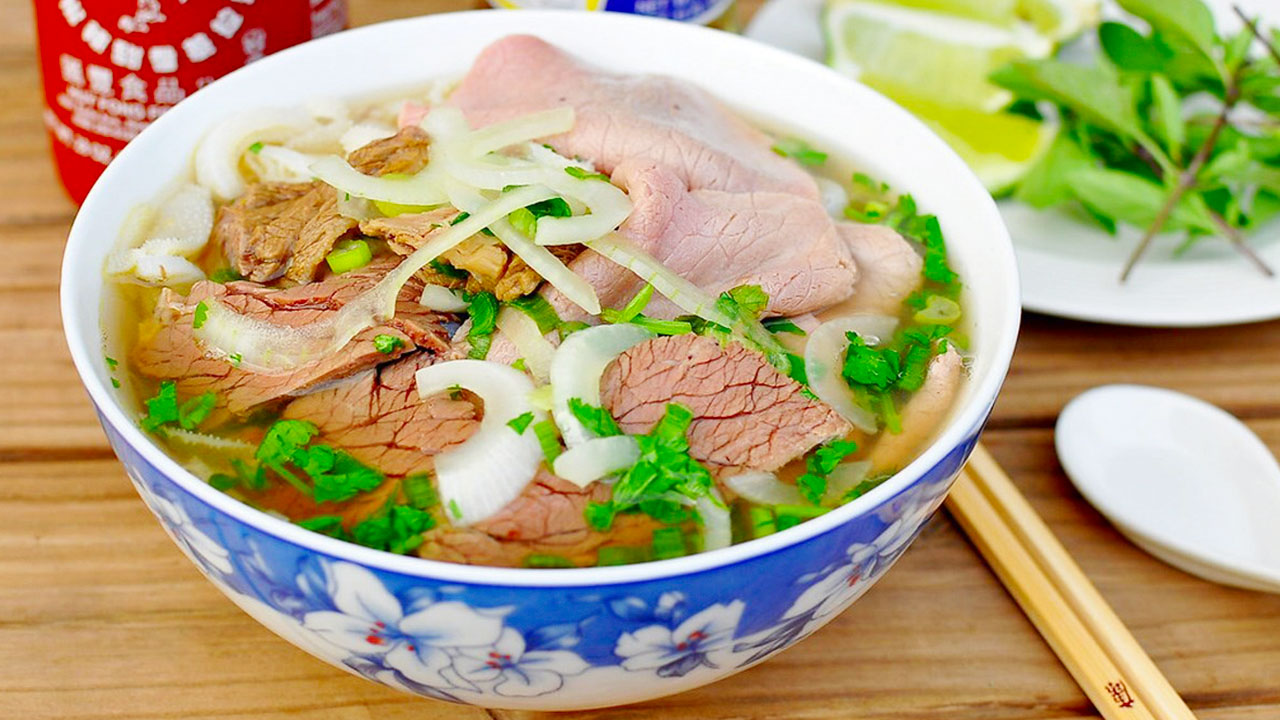
Phở bò, also known as beef noodle soup, is the quintessential pho dish that has become synonymous with Vietnamese cuisine. Served in a steaming hot bowl, phở bò tantalizes the senses with its rich and flavorful broth. The broth is painstakingly crafted using beef bones, spices, and herbs, simmered for hours until it reaches a deep, savory perfection.
At the heart of phở bò lies the tender rice noodles, which soak up the delicious broth and provide a delightful textural contrast. The noodles are accompanied by thinly sliced beef, which is cooked to perfection, ensuring it remains tender and juicy. Phở bò is typically served with a generous helping of fresh herbs, including basil, cilantro, and mint, which add a burst of aromatic freshness to the dish.
-
Phở gà (Chicken Noodle Soup): A Lighter Alternative
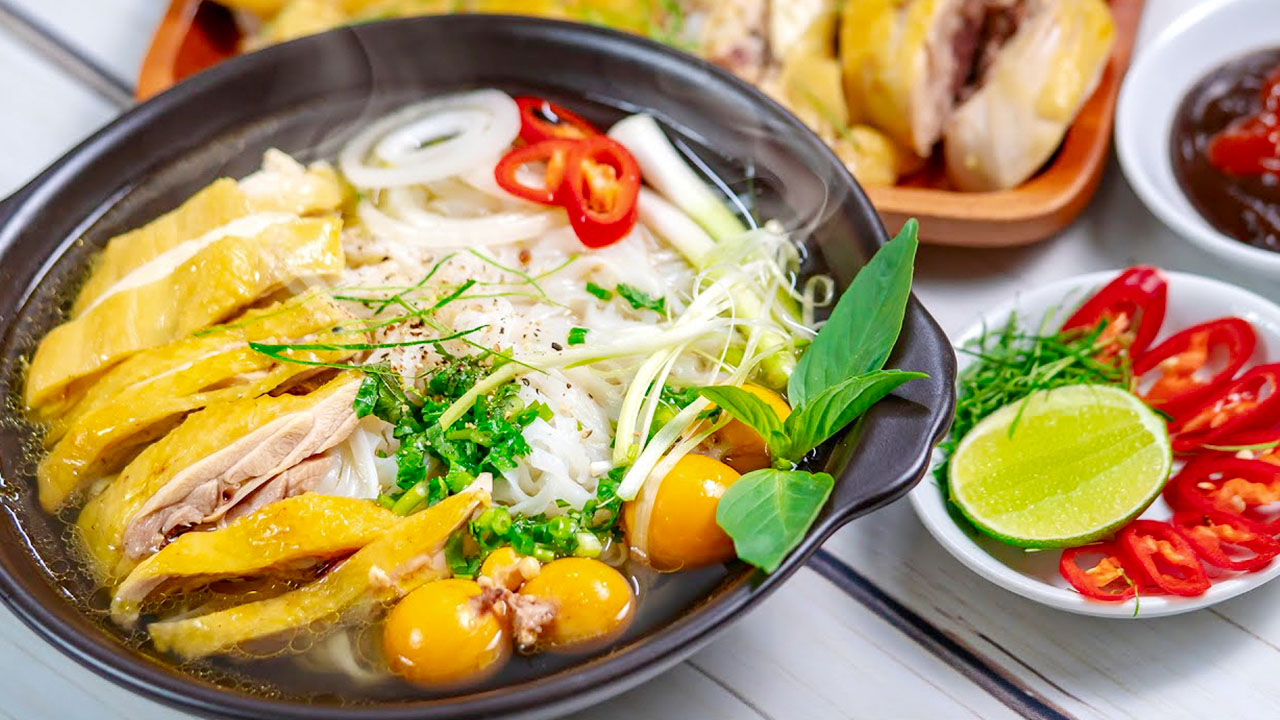
For those who prefer a lighter option, phở gà, or chicken noodle soup, is a popular alternative to phở bò. The broth is made with chicken bones, ginger, and onions, resulting in a lighter and clearer broth compared to the beef version. The noodles are also thinner and more delicate, making it a perfect choice for those looking for a lighter meal.
-
Phở cuốn (Pho Rolls): A Unique Twist on Pho
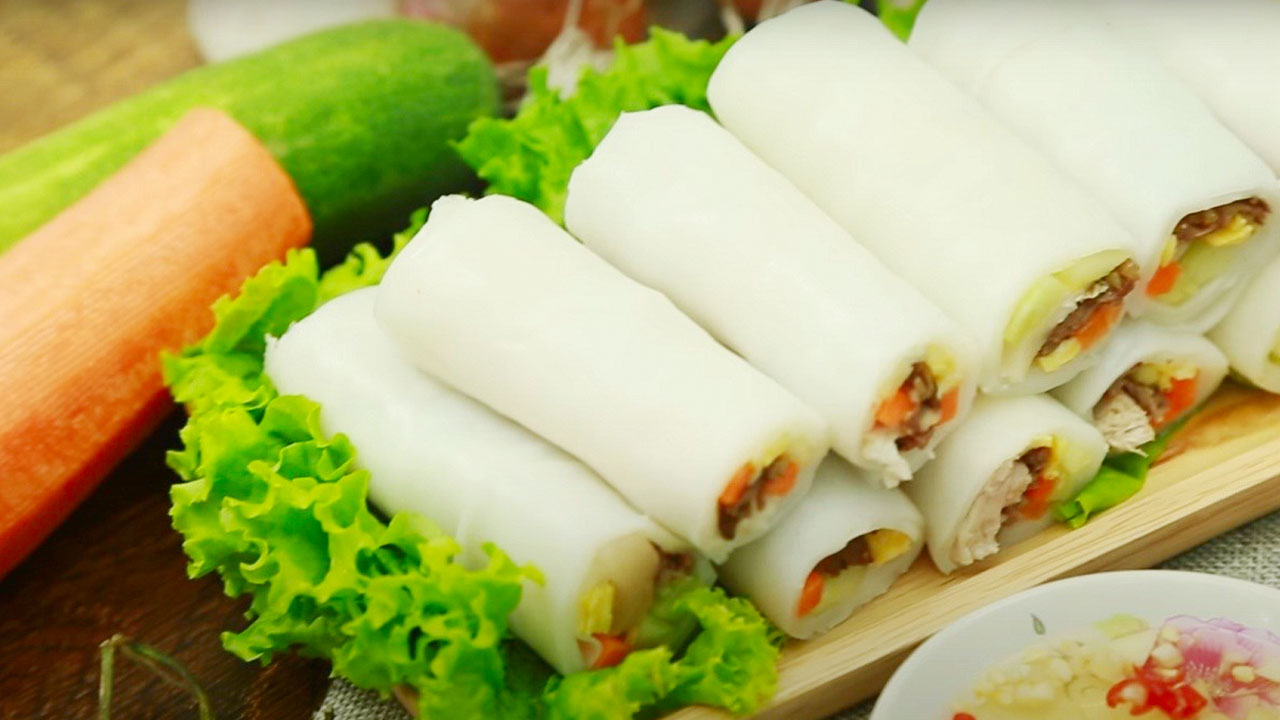
Phở cuốn, or pho rolls, is a unique twist on the traditional pho dish. Instead of being served in a bowl, the ingredients of phở bò or phở gà are wrapped in rice paper and served cold. The rice paper is filled with rice noodles, herbs, and either beef or chicken, and then dipped in a sweet and tangy sauce before being eaten.
Phở cuốn originated in Hanoi and has gained popularity in recent years, with many restaurants specializing in this dish. It is a refreshing and lighter alternative to the traditional pho dishes, making it a popular choice during the hot summer months.
While the basic ingredients of phở cuốn remain the same, there are variations in the types of herbs and sauces used. Some restaurants also offer vegetarian options, using tofu or mushrooms instead of meat. Phở cuốn can also be served as an appetizer or a main dish, depending on the portion size.
-
Phở chiên phồng (Puffed Fried Pho): A Unique Street Food Experience

Phở chiên phồng, or puffed fried pho, is a popular street food in Hanoi that offers a unique and delicious experience. The dish starts with a layer of crispy deep-fried pho noodles, topped with stir-fried beef, vegetables, and a savory sauce. The noodles soak up the flavors of the toppings, resulting in a burst of flavors and textures in every bite.
Recommended places to eat Pho:
- Phở Gia Truyền (Traditional) – 49 Bat Dan, Hoan Kiem, Hanoi
- Phở 10 Lý Quốc Sư (Traditional) – 10 Ly Quoc Su, Hoan Kiem, Hanoi
- Phở Thìn Bờ Hồ (Traditional) – 61 Dinh Tien Hoang Street, Hoan Kiem District, Hanoi
- Phở cuốn 31 Ngũ Xã (Rolls) – 31 Ngu Xa Street, Ba Dinh District, Hanoi
- Phở chiên Nguyễn Siêu (Puffed Fried)- 10 Nguyen Sieu Street, Hoan Kiem District, Hanoi
II- Bánh mì Hà Nội (Hanoi Bread)

Banh Mi Hanoi, a popular Vietnamese dish, originated from French baguettes brought to South Vietnam in the 20th century. Vietnamese bread became popular globally after the migration of Vietnamese people post-1975 and was even recognized as one of the world’s top street foods by The Guardian in 2012.
Banh Mi is a staple in Vietnamese daily life, enjoyed for breakfast, lunch, dinner, or as a snack anytime. It offers incredible versatility as a dish, catering to various preferences and occasions.
Recommended places to eat Banh Mi Hanoi:
- Banh Mi 25 – 25 Hang Ca street, Hoan Kiem district, Hanoi
- Banh Mi Pho – 38 Dinh Liet street, Hoan Kiem district, Hanoi
- Vegan Banh Mi – 66B Tran Hung Dao street, Hoan Kiem district, Hanoi
- Banh Mi Pho Hue – 118A Hue street, Hai Ba Trung district, Hanoi
- Banh Mi Lan Ong – 20 Cha Ca street, Hoan Kiem district, Hanoi
III- Các loại bún, mì ở Hà Nội (Noodles in hanoi)
Noodles have been a staple in Vietnamese cuisine for centuries, with each region having its own unique variations and specialties. In Hanoi, noodles are an integral part of the local food culture, with countless street vendors and restaurants serving up their own versions of noodle dishes. From soups to stir-fries, there is no shortage of options when it comes to noodles in Hanoi.
One of the most popular types of noodles in Hanoi is rice vermicelli, also known as bún. These thin, translucent noodles are made from rice flour and are used in a variety of dishes, from soups to salads. Another common type of noodle is bánh đa, which are flat rice noodles that are thicker and wider than bún. These noodles are often used in stir-fries and noodle soups.
-
Bún chả (Grilled Pork With Rice Vermicelli)

Bún chả, a beloved dish in Hanoi, is a testament to the perfect harmony between grilled pork and rice vermicelli. This dish originated in Hanoi and has become a favorite among locals and tourists alike. The dish consists of grilled pork, served alongside a bowl of rice vermicelli, fresh herbs, and a dipping sauce.
Ingredients:
- Thinly sliced pork
- Rice vermicelli noodles
- Fresh herbs (such as mint, coriander, and perilla)
- Dipping sauce (made from fish sauce, vinegar, sugar, and chili peppers)
To make bún chả, the pork is marinated in a special blend of spices and herbs, then grilled over hot coals until it is crispy and caramelized. The vermicelli noodles are cooked until soft and chewy, providing a delightful contrast to the crispy pork. The dish is typically served with a dipping sauce made from fish sauce, vinegar, sugar, and chili peppers, adding a tangy and spicy kick to the dish.
-
Bún riêu (Crab Noodles)
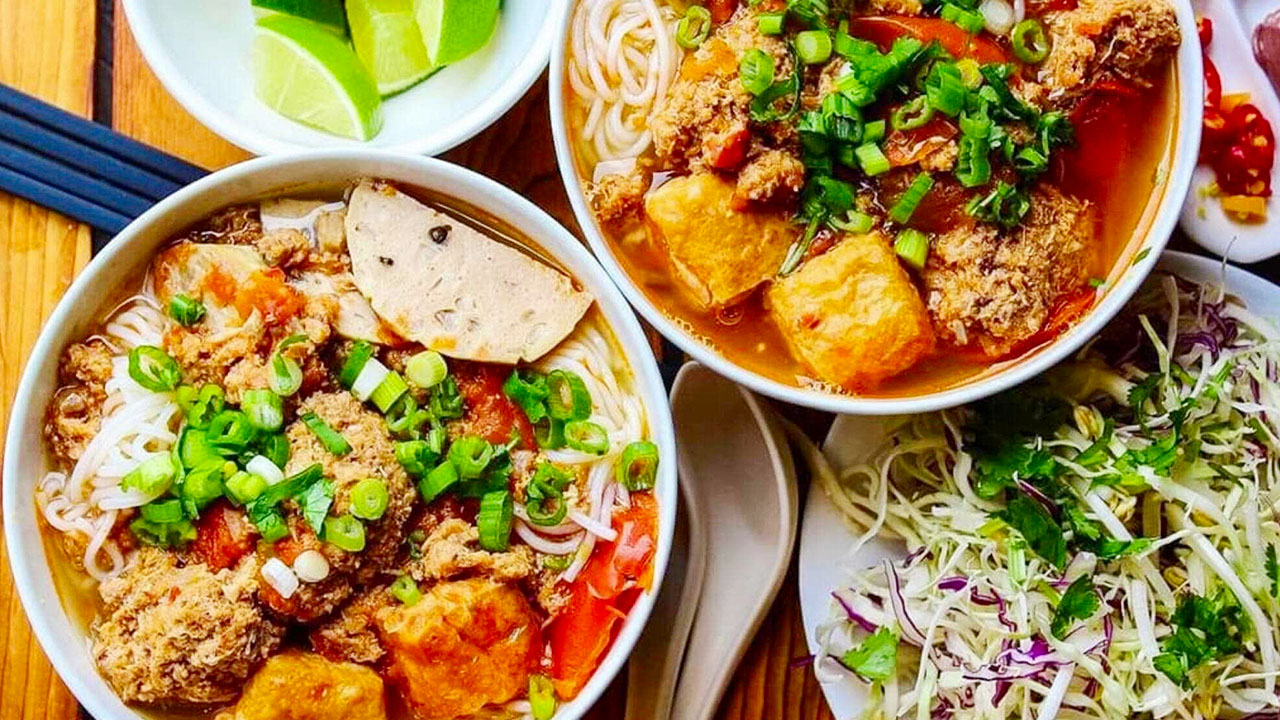
Bún riêu is a rich and flavorful noodle soup that showcases the bounty of the sea. This dish originated in Northern Vietnam and has become a popular street food in Hanoi. The broth is made from a combination of tomatoes, crab, pork bones, and shrimp paste, resulting in a complex and savory flavor.
Ingredients:
- Crab meat
- Pork bones
- Shrimp paste
- Tomatoes
- Tofu
- Rice vermicelli noodles
- Bean sprouts
- Basil
- Lime wedges
The broth is simmered for hours, allowing all the flavors to meld together. Rice vermicelli noodles are added to the broth, along with chunks of crab, tomatoes, tofu, and a variety of herbs. The dish is often served with a side of bean sprouts, basil, and lime wedges, allowing diners to customize the soup to their liking.
-
Bún ốc (Snail Noodle Soup)
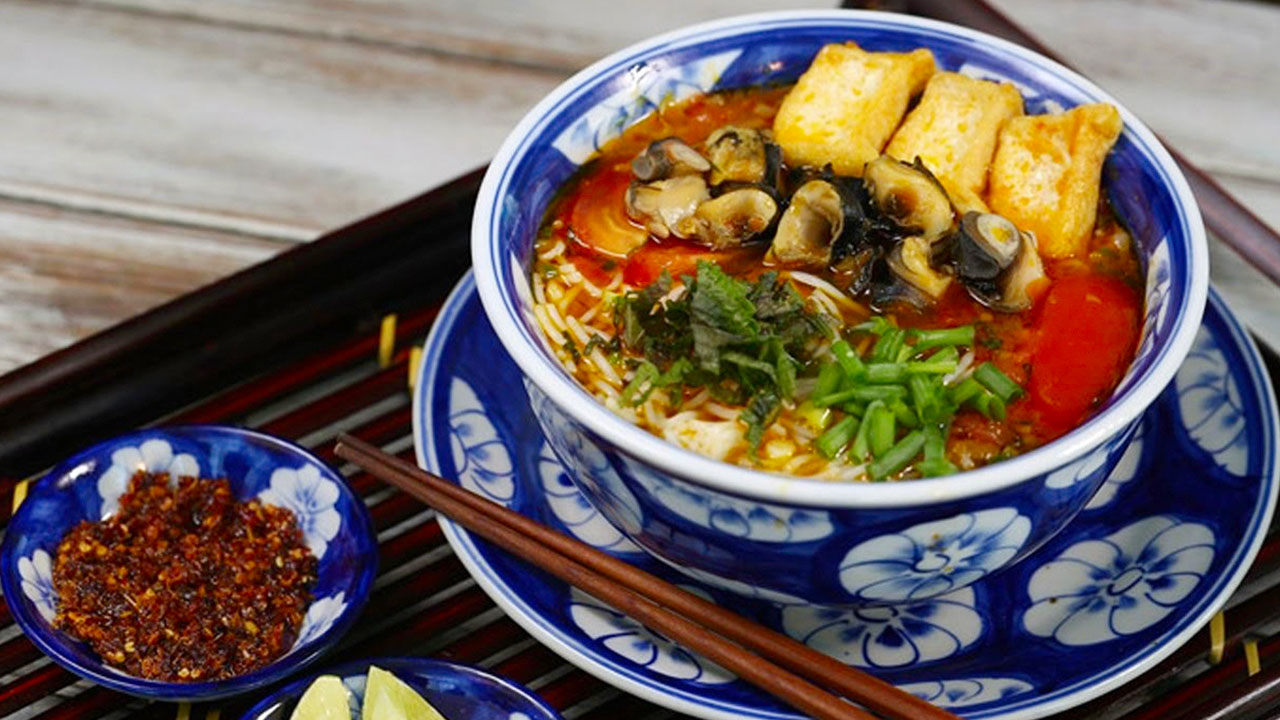
Bún ốc is a popular street food in Hanoi, especially during the colder months. This noodle soup is made with a rich and flavorful broth, filled with a variety of snails and herbs. The dish is often topped with fried tofu and served with a side of chili sauce for an extra kick.
Ingredients:
- Snails
- Fried tofu
- Rice vermicelli noodles
- Fresh herbs (such as mint, coriander, and perilla)
- Chili sauce
The broth for bún ốc is made by simmering pork bones, dried shrimp, and spices for hours, resulting in a rich and fragrant base. The snails are added to the broth towards the end of the cooking process, allowing them to soak up all the flavors. The dish is then assembled by adding rice vermicelli noodles to a bowl, topping it with the snail broth, and garnishing it with fresh herbs and fried tofu.
-
Bún cá (Noodle Soup With Fish)

Bún cá is a popular noodle soup in Hanoi that features fish as the main protein. This dish is believed to have originated in the coastal city of Hai Phong and has since become a staple in Hanoi’s food scene. The broth for bún cá is made from fish bones, tomatoes, and a variety of herbs, resulting in a light and refreshing flavor.
Ingredients:
- Fish fillets
- Fish bones
- Tomatoes
- Rice vermicelli noodles
- Fresh herbs (such as dill, coriander, and scallions)
To make bún cá, the fish fillets are marinated in a special blend of spices and herbs, then grilled or pan-fried until crispy. The broth is made by simmering fish bones, tomatoes, and herbs for hours, resulting in a flavorful and aromatic base. The dish is then assembled by adding rice vermicelli noodles to a bowl, topping it with the fish broth, and garnishing it with fresh herbs.
-
Bún thang (Noodle soup with various toppings)
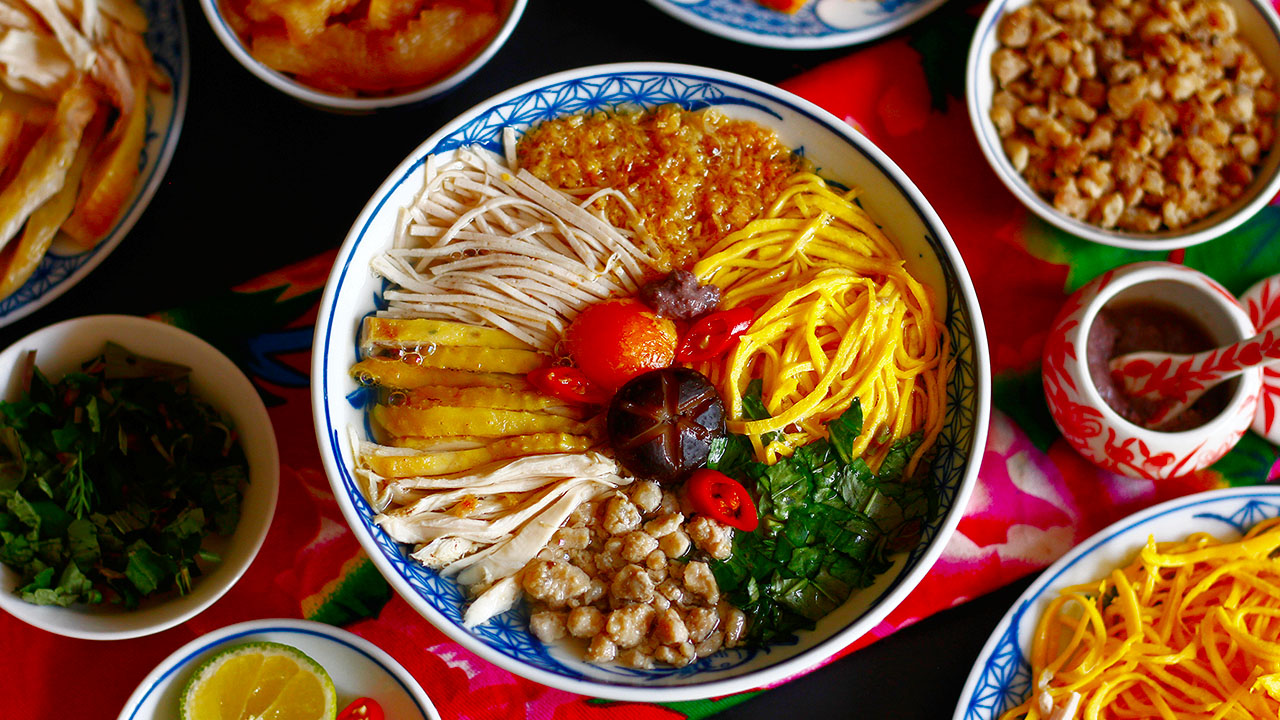
Bún thang is a noodle soup that is often served during special occasions, such as weddings or Lunar New Year celebrations. This dish is a combination of different toppings, making it a hearty and satisfying meal. The broth for bún thang is made from chicken bones, dried shrimp, and pork bones, resulting in a rich and flavorful base.
Ingredients:
- Chicken breast
- Dried shrimp
- Pork bones
- Rice vermicelli noodles
- Eggs
- Fried tofu
- Vietnamese ham (chả lụa)
- Fresh herbs (such as cilantro, scallions, and perilla)
To make bún thang, the chicken breast is poached in the broth until cooked through, then thinly sliced. The broth is then strained and simmered with dried shrimp and pork bones to enhance the flavor. The dish is assembled by adding rice vermicelli noodles to a bowl, topping it with the broth, and garnishing it with thinly sliced chicken, eggs, fried tofu, Vietnamese ham, and fresh herbs.
-
Bánh đa trộn (Mixed Flat Rice Noodles)
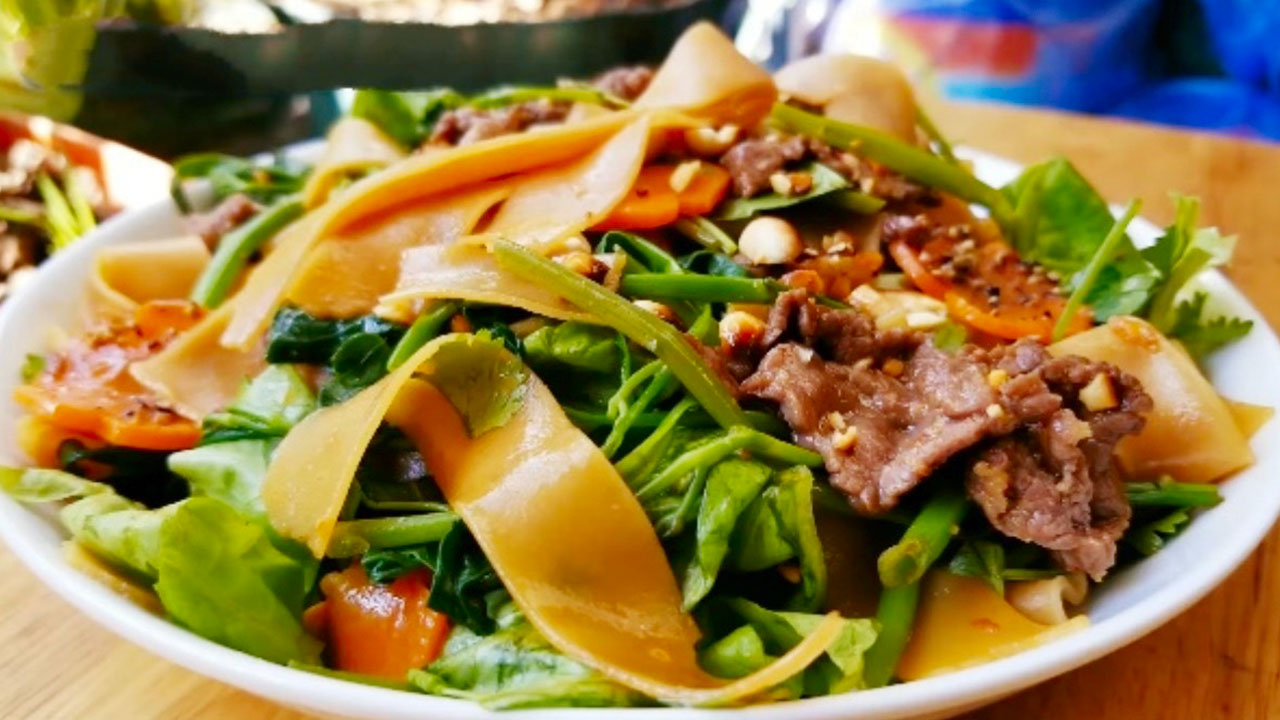
Bánh đa trộn is a popular street food in Hanoi that features mixed flat rice noodles, tossed in a variety of toppings and sauces. This dish is a favorite among locals for its simplicity and versatility. The noodles are typically served cold, making it a perfect dish for hot summer days.
Ingredients:
- Mixed flat rice noodles
- Grilled pork
- Fried tofu
- Vietnamese ham (chả lụa)
- Bean sprouts
- Fresh herbs (such as mint, coriander, and perilla)
- Fish sauce dressing
To make bánh đa trộn, the mixed flat rice noodles are cooked until soft, then tossed in a fish sauce dressing. The noodles are then topped with grilled pork, fried tofu, Vietnamese ham, bean sprouts, and fresh herbs. The dish is often served with a side of chili sauce for those who prefer a spicy kick.
-
Miến xào lươn (Glass Noodles With Eel)
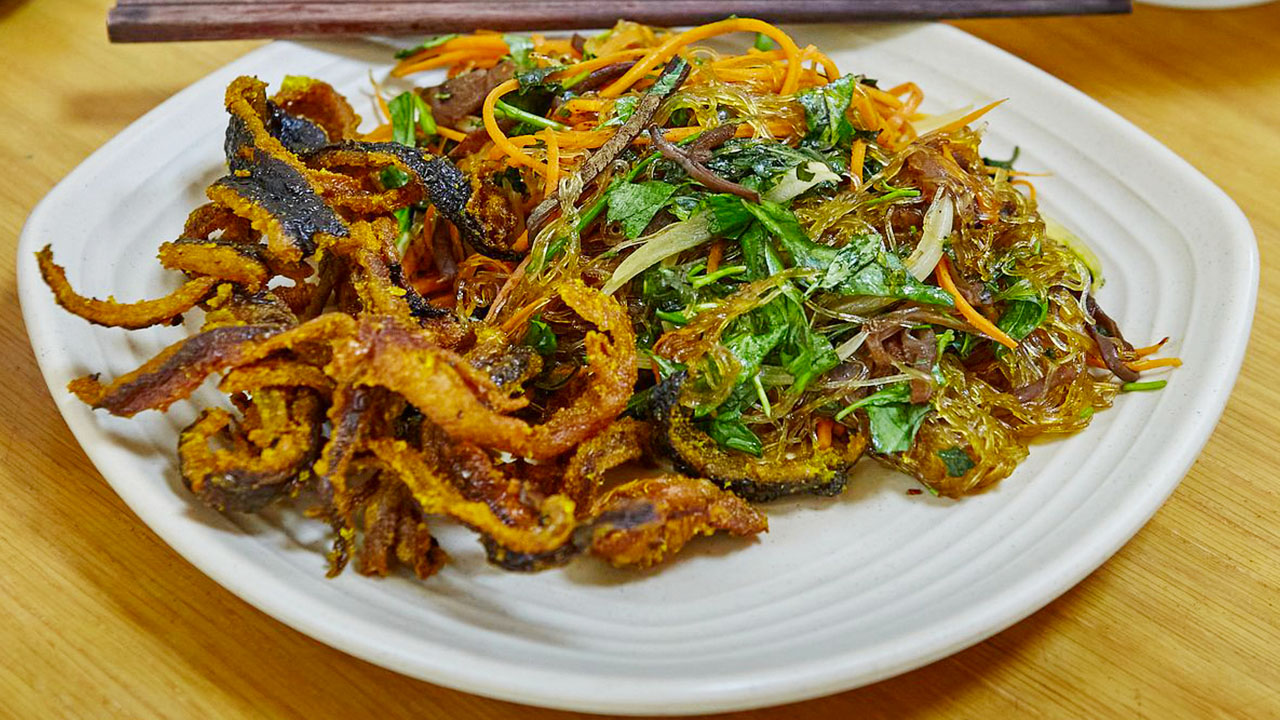
Miến xào lươn is a popular stir-fried noodle dish in Hanoi that features glass noodles and eel. This dish is a perfect example of the fusion of Chinese and Vietnamese cuisine, with the use of glass noodles and eel being influenced by Chinese cooking techniques.
Ingredients:
- Glass noodles
- Eel
- Vegetables (such as carrots, bell peppers, and onions)
- Soy sauce
- Oyster sauce
- Fish sauce
- Sugar
To make miến xào lươn, the eel is marinated in a mixture of soy sauce, oyster sauce, fish sauce, and sugar, then stir-fried with vegetables and glass noodles. The dish is typically served with a side of fresh herbs and lime wedges.
Recommended places to eat Nodles Hanoi:
- Bun Cha Hang Quat – 74 Hang Fan Street, Hoan Kiem District, Hanoi
- Bun Cha Huong Lien – 24 Le Van Huu Street, Hai Ba Trung District, Hanoi.
- Bun Cha Hanoi Dac Kim – Hang Manh, Hang Gai Street, Hoan Kiem District, Hanoi.
- Bun rieu Hang Bo – 44 Hang Bo Street, Hoan Kiem District, Hanoi
- Bun rieu cua Hang Bac – 11 Hang Bac Street, Hoan Kiem District, Hanoi
- Mien luon Minh Lan – 1 Chan Cam Street, Hoan Kiem District, Hanoi
- Bun ca Hang Dau – 42 Hang Dau Street, Hoan Kiem District, Hanoi
IV- Các loại bánh (Cakes)
-
Bánh cuốn (Steamed Rice Paper Rolls)
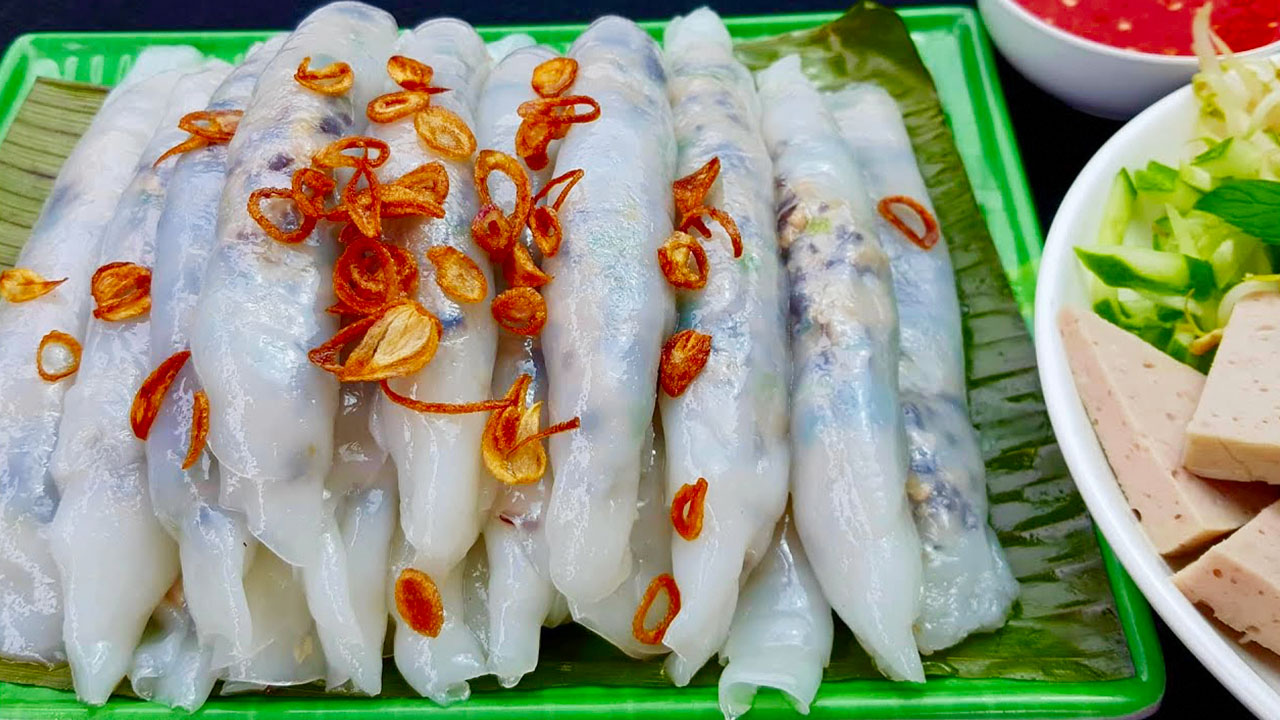
Bánh cuốn, a symbol of Hanoi’s culinary identity, embodies a delicate interplay of textures and flavors. Thin sheets of steamed rice paper envelop a savory filling of minced pork and wood ear mushrooms, creating a translucent delight. Served with a dipping sauce of tangy fish sauce, tinged with the sweetness of sugar and the heat of chili, this dish is a symphony of flavors that harmonizes perfectly.
The key to great bánh cuốn lies in the steaming process. The rice batter is steamed to just the right consistency so that the rice sheets are soft and slippery, yet intact enough to cradle the filling. When you bite into a perfectly steamed bánh cuốn, it feels like a silk ribbon dissolving on your tongue.
Where to Eat in Hanoi
Some of the best places in Hanoi to enjoy bánh cuốn include Gia An, at 28 Phan Chu Trinh Street, and Bánh Cuốn Gia Truyền Thanh Van, at 12 Hang Ga Street. Both serve this delicate dish with a rich, flavorful broth and homemade chili sauce. For a modern twist, Cuốn Viet, at 9 Hang Bo Street, offers unique fillings like chicken floss and dried shrimp.
-
Bánh xèo (Crispy Pancakes)
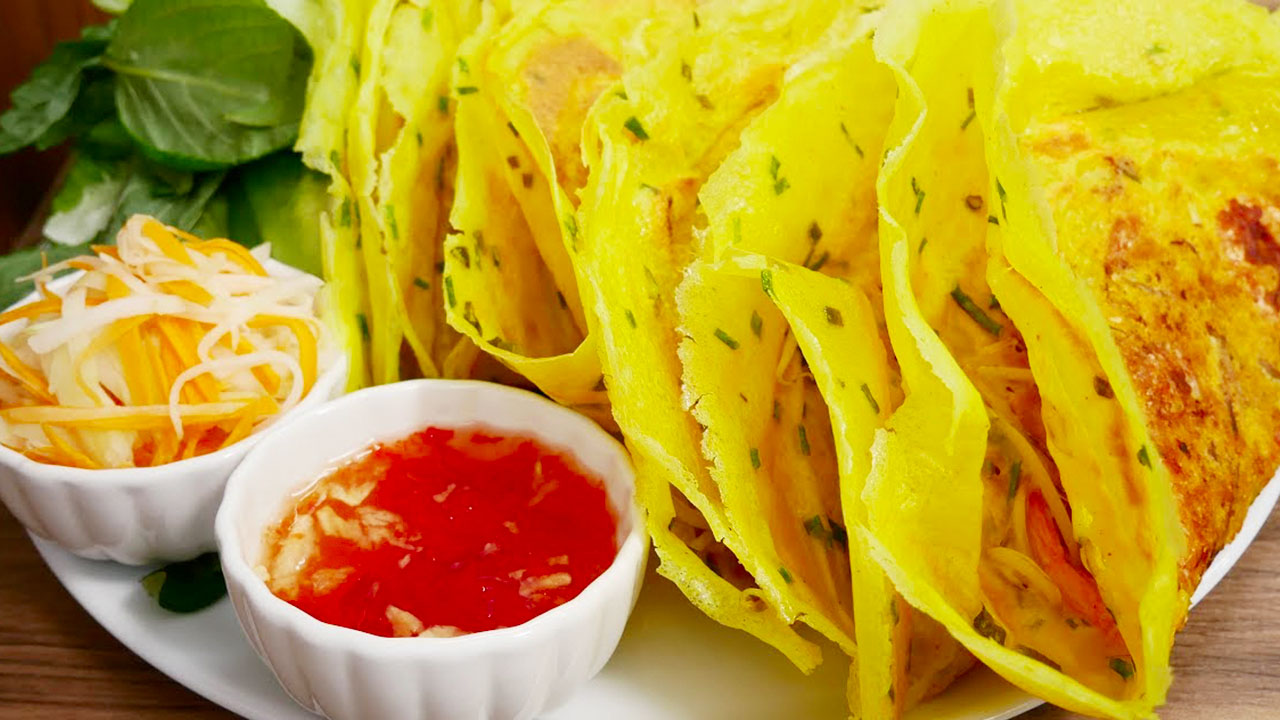
Bánh xèo, a sizzling spectacle on a hot griddle, is a crispy explosion of golden goodness. A thin batter, enriched with turmeric, forms the base upon which a medley of ingredients dance in harmony. Tender pork, succulent shrimp, crunchy bean sprouts, and the aromatic greens of cilantro and scallions create a diverse culinary tapestry. Accompanied by a fish sauce-based dipping sauce, this dish is a celebration of textures and flavors.
Good bánh xèo has a delicate balance of crispy and soft textures. The pancake should sizzle on the griddle while the turmeric-infused batter bubbles up around the edges. By the time it gets to your table, the pancake exterior should be crispy, yet give way to reveal a soft interior filled with savory delights.
Favorite Joints in Hanoi
Some top spots for feasting on bánh xèo include Pho Thin at 13 Lo Duc Street, where they are cooked on small grills right at your table, and Thanh Nien at 52 Ly Quoc Su Street, which has perfected the classic shrimp and pork filling. For a contemporary twist, Koto Van Mieu at 59 Van Mieu Street adds interesting fillings like chicken floss, spring rolls, and tofu.
-
Bánh tôm (Hanoi Shrimp Cakes)

Bánh tôm, a Hanoi specialty, captivates with its contrasting textures. Shredded shrimp, enveloped in a crispy batter, yields a symphony of contrasting textures. The golden-brown exterior gives way to the tender and juicy interior, while the dipping sauce, a harmonious blend of fish sauce, fresh herbs, and chili, completes this symphony of flavors.
The perfection of bánh tôm lies in achieving the right balance of crispy exterior and tender, shrimp-filled interior. Frying at high heat helps seal in the juices while crisping up the outside to a beautiful golden brown. The dipping sauce provides a salty, savory burst of flavor to contrast with the sweet succulence of the shrimp cakes.
Local Legends
Some long-standing favorites for savoring shrimp cakes include Banh Tom Ho Tay at 1 Thanh Nien Street, Tay Ho District, Hanoi. Their cakes achieve peak crispness. For a modern ambiance try Bánh tôm Cô Ầm at Dong Xuan Alley, Hang Chieu, Hoan Kiem, Hanoi, where the shrimp cakes are served with special sauce for a sweet twist.
-
Bánh rán (Donuts)
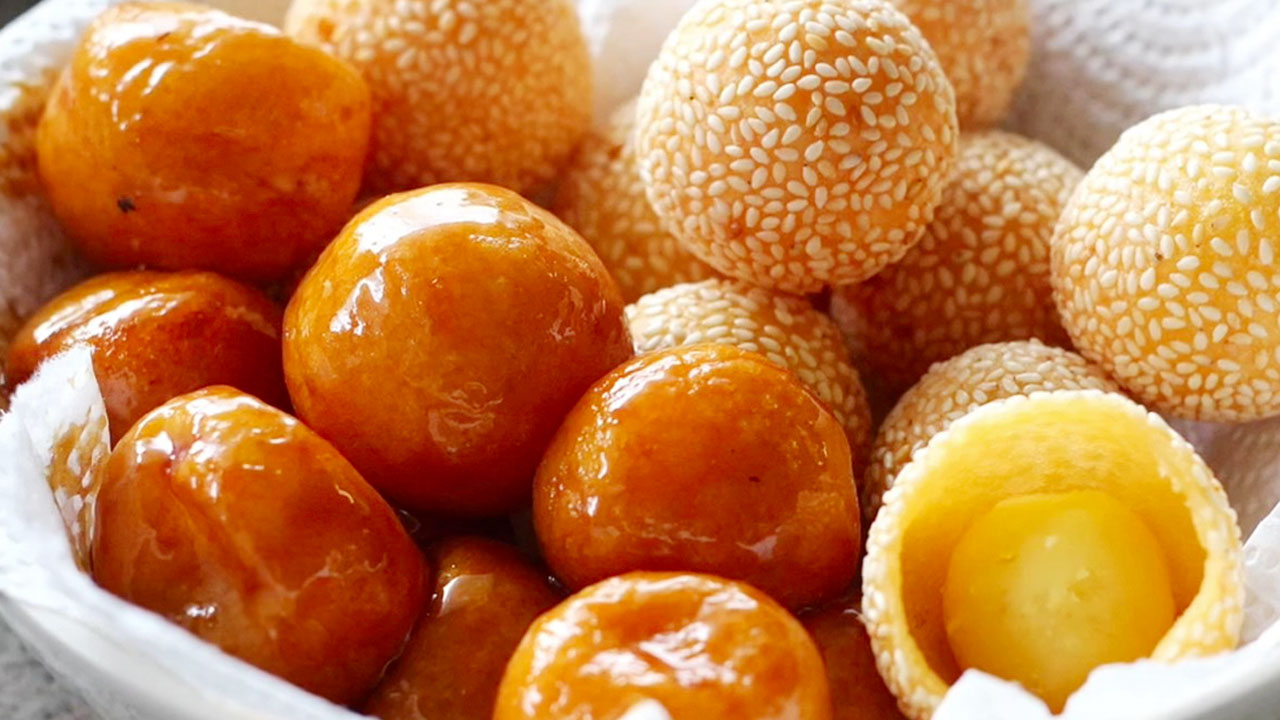
Bánh rán, a nostalgic sweet treat, carries the legacy of Hanoi’s street food scene. These deep-fried donuts, generously coated in sesame seeds, offer a comforting warmth, enveloping the soft and fluffy interior. Whether enjoyed plain or filled with sweet mung bean paste, bánh rán is a timeless classic, evoking memories of childhood and simpler times.
Well-made bánh rán achieves an ideal balance of a crispy fried exterior and a soft, cloud-like interior. Frying at the right temperature prevents the donuts from becoming greasy while allowing them to turn a perfect golden brown. The sesame seed coating provides texture and nutty undertones.
Where to Find the City’s Best
Some beloved spots for savoring bánh rán include:
- Bánh rán Ô Quan Chưởng – Corner of Quan Chuong – Hang Chieu intersection, Hoan Kiem district, Hanoi.
- Bánh rán Đinh Liệt – 16 Dinh Liet Street, Hoan Kiem District, Hanoi.
- Bánh rán Gia Trịnh – Lane 16A Ly Nam De, Hoan Kiem District, Hanoi.
-
Bánh cốm (Green sticky rice cake)
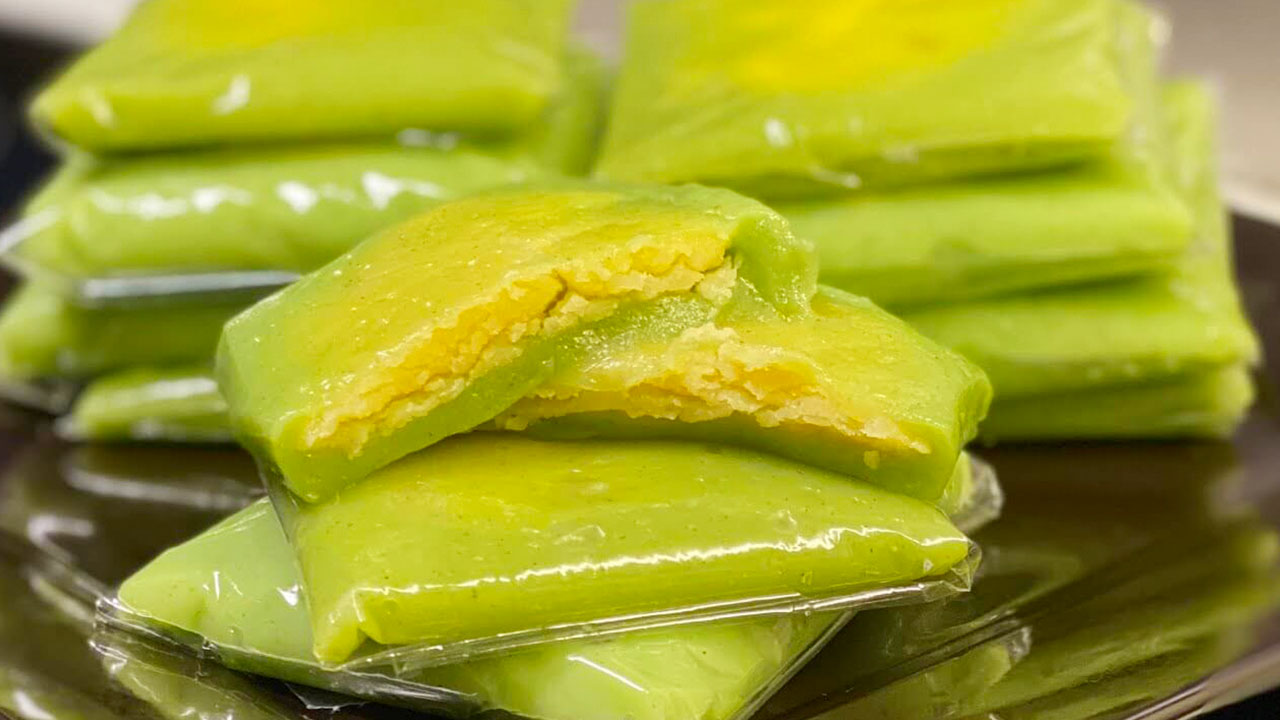
Bánh cốm, a poetic expression of Vietnamese tradition, is a symphony of green, white, and purple hues. Steamed sticky rice, infused with the aromatic essence of roasted young rice grains, creates a delicate and chewy texture. A generous sprinkle of coconut flakes adds a delightful sweetness, while mung bean paste offers a complementary richness. This exquisite cake, wrapped in banana leaves, is a true work of art, capturing the essence of Hanoi’s culinary heritage.
Making bánh cốm by hand is an intricate process that has been passed down for generations. The young rice is roasted until perfectly aromatic before being ground into a paste and mixed with the sticky rice. Steaming lend the cakes their chewy yet delicate consistency. Wrapping the cakes in fragrant banana leaves seals in the subtle flavors.
Where to Buy in Hanoi
- Bánh cốm Nguyên Ninh Hàng Than – 11 Hang Than Street, Ba Dinh District, Hanoi.
- Bánh cốm Hàng Than Hà Nội Xưa Nay – 60 Hang Than Street, Ba Dinh District, Hanoi.
- Bánh cốm Hà Nội Hồng Ninh – 79 Hang Than Street, Ba Dinh District, Hanoi.
V- Các món nướng và lẩu (Grilled dishes and hot pot)
-
Lẩu (Hot-pot)
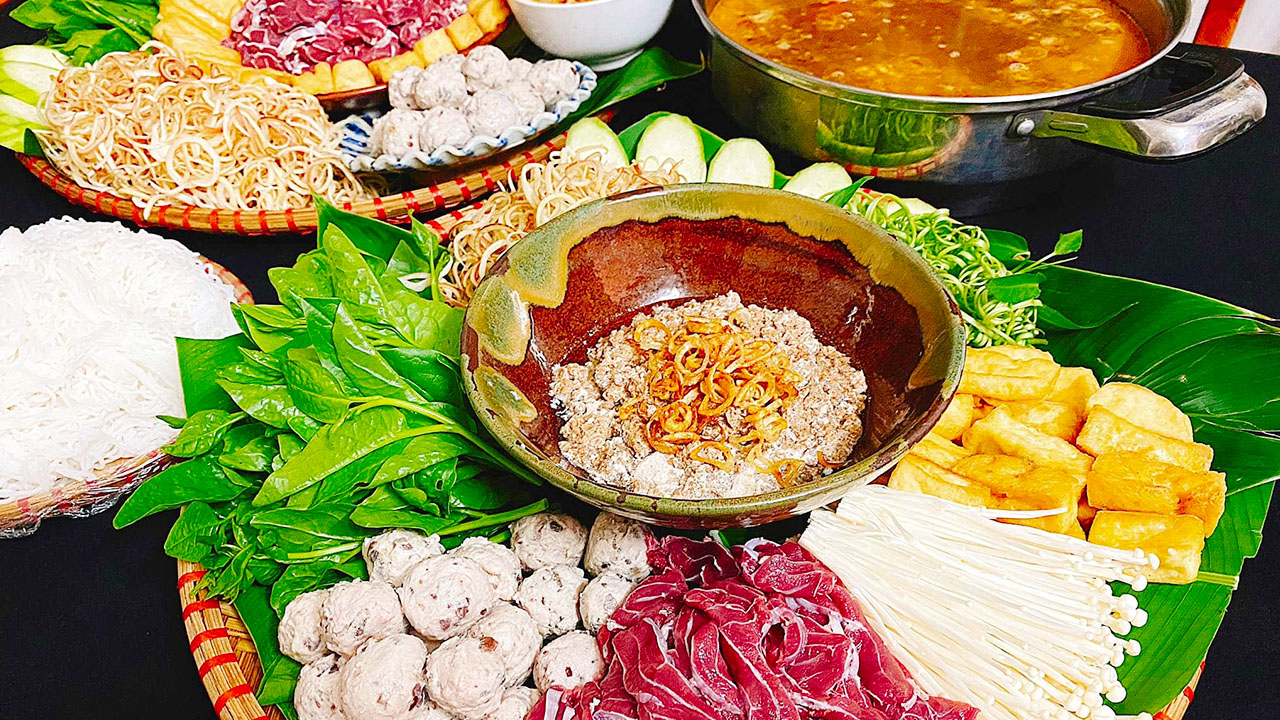
A Culinary Symphony of Heat and Flavor
Lẩu, a communal dining experience, embodies the vibrant spirit of Hanoi’s street food. A simmering pot, filled with a fragrant broth and an array of meats, seafood, vegetables, and noodles, takes center stage. Each ingredient contributes its unique flavor, harmonizing with the others to create a captivating symphony of heat and savoriness. This interactive culinary journey allows diners to create their own personalized masterpiece.
Fragrant Broths
The foundation of a phenomenal lẩu is the broth, which infuses the ingredients with spice and depth of flavor. Popular bases include tangy tomato broth, fiery kimchi broth, aromatic lemongrass broth, and rich seafood broth. Thinly sliced meat cooks quickly and absorbs the broth’s essence.
Hotspot Restaurants
- Lẩu Đức Trọc – 69 Pho Duc Chinh Street, Ba Dinh District, Hanoi.
- Lẩu riêu cua 66 Phó Đức Chính – 6 Pho Duc Chinh Street, Ba Dinh District, Hanoi.
- Nhà Hàng Thái Koh Yam – 34 Quan Trung Street, Hoan Kiem District, Hanoi.
- Kichi-Kichi – 5th Floor, Trang Tien Plaza Shopping Center, 24 Hai Ba Trung, Hoan Kiem District, Hanoi
- Tùng Lẩu Ngõ Trạm – 165A Phung Hung Street, Hoan Kiem District, Hanoi.
-
Thịt nướng (Barbecue)

Thịt nướng, the smoky ambassador of Hanoi’s street food, tantalizes with its charred exterior and tender interior. Skewers of marinated meats, each possessing its own distinct character, sizzle and dance over hot coals. Pork, chicken, and beef, infused with herbs and spices, unleash a burst of flavors with each bite. Accompanied by rice noodles, fresh herbs, and a tangy dipping sauce, thịt nướng is a feast for the senses.
The marinade makes all the difference in thịt nướng, tenderizing the meat and infusing it with flavor. Common marinade ingredients include lemongrass, shallots, fish sauce, honey, and soy sauce. Grilling over charcoal adds a lovely smokiness.
Hot Spots Sizzling with Skewers
Some local favorites for feasting on thịt nướng skewers are Bia Hoi Ha Noi at 21 Duong Thanh Street, serving juicy pork skewers in a lively open-air setting, and Ta Hien Street, where you can barbecue right at your place.
VI- Cà phê Hà Nội (Hanoi Coffee)
-
Cà phê đen (Black coffee)

For many Vietnamese, a cup of rich, bitter cà phê đen is the preferred daily wakeup call. This intense black coffee brewed from dark-roasted beans served hot or iced packs a serious punch of caffeine. A touch of sweetened condensed milk balances out the bold bitterness.
Cà phê đen showcases the quality and flavor of the beans. Vietnamese beans like Robusta are roasted with sugar for a caramelized aroma and deeper bitterness. The coffee is prepared using a small metal drip filter, resulting in a dark, robust brew.
-
Cà phê sữa (Milk coffee)

Cà phê sữa, served at cafes across Vietnam, blends rich coffee with sweetened condensed milk to create a famously velvety and indulgent treat. The contrast between the deep, earthy espresso and the silky milk is nothing short of magical.
A perfectly crafted cà phê sữa relies on getting the layers just right. The condensed milk is added first, coating the bottom of the glass. The espresso is then poured gently and slowly to allow the two liquids to integrate into a smooth emulsion.
-
Cà phê trứng (Egg Coffee)
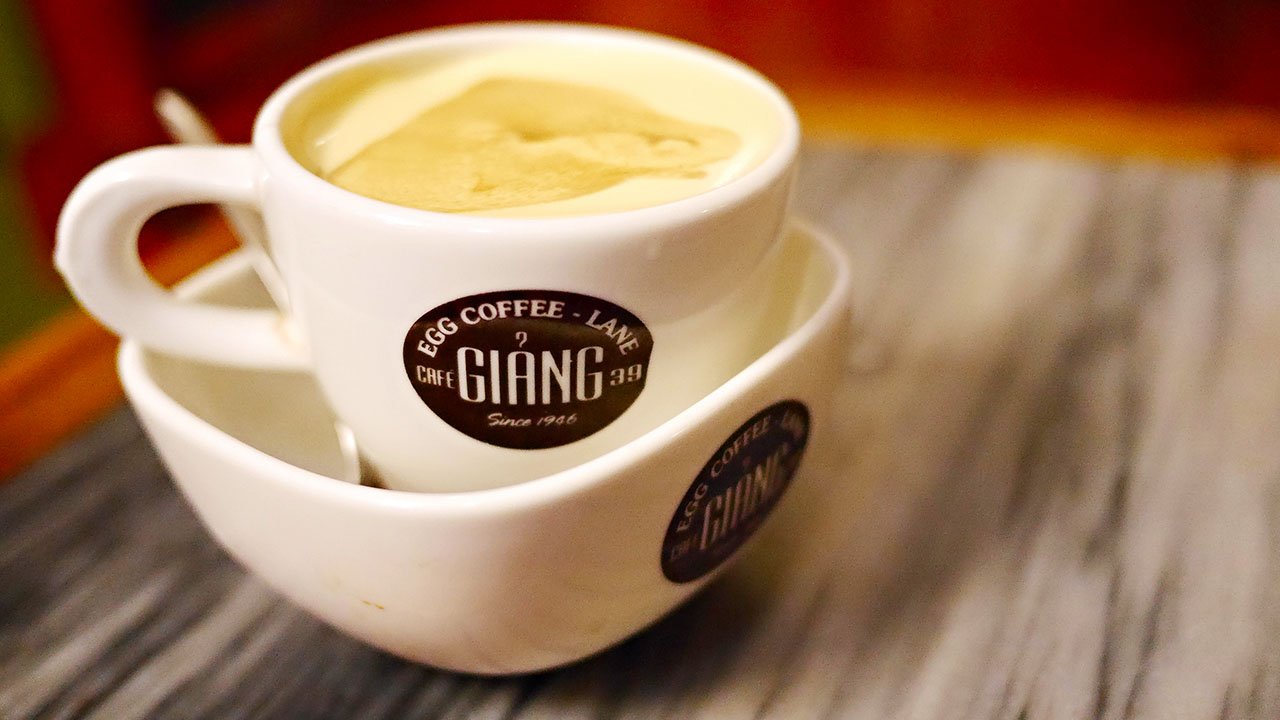
A Hanoi treasure, cà phê trứng sees beaten egg yolks whisked into cà phê sữa for a fluffy, custard-like treat. The egg foam creates a fat topping crowning the coffee, lending richness and body. Served warm or over ice, this special coffee indulgence embodies Hanoi’s cafe culture.
Cà phê trứng hinges on perfectly beaten egg yolks to achieve its signature foamy topping. Sugar is caramelized to enhance the egg’s fluffiness before being folded into the yolks. When combined with coffee, magic ensues.
-
Cà phê muối (Salt coffee)
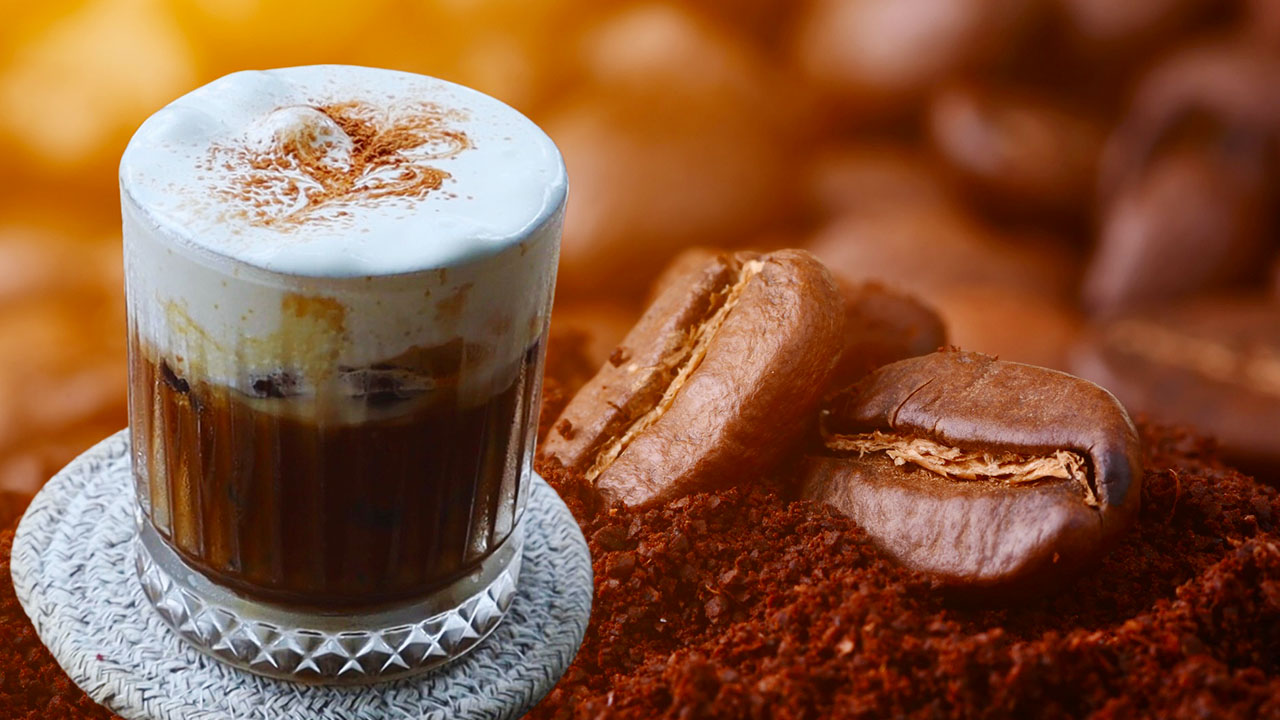
Native to Hanoi, cà phê muối features an unlikely twist – a sprinkle of salt atop the sweetened coffee. This surprising combination of salty and sweet marries beautifully. The touch of salt enhances the drink’s bittersweet complexity.
Cà phê muối relies on achieving the right salty-sweet balance. Too much salt overpowers while too little fades into the background. When done well, the salt elevates and accentuates the coffee’s inherent flavors.
VII- Other street foods in Hanoi
-
Chả cá (Grilled Fish)
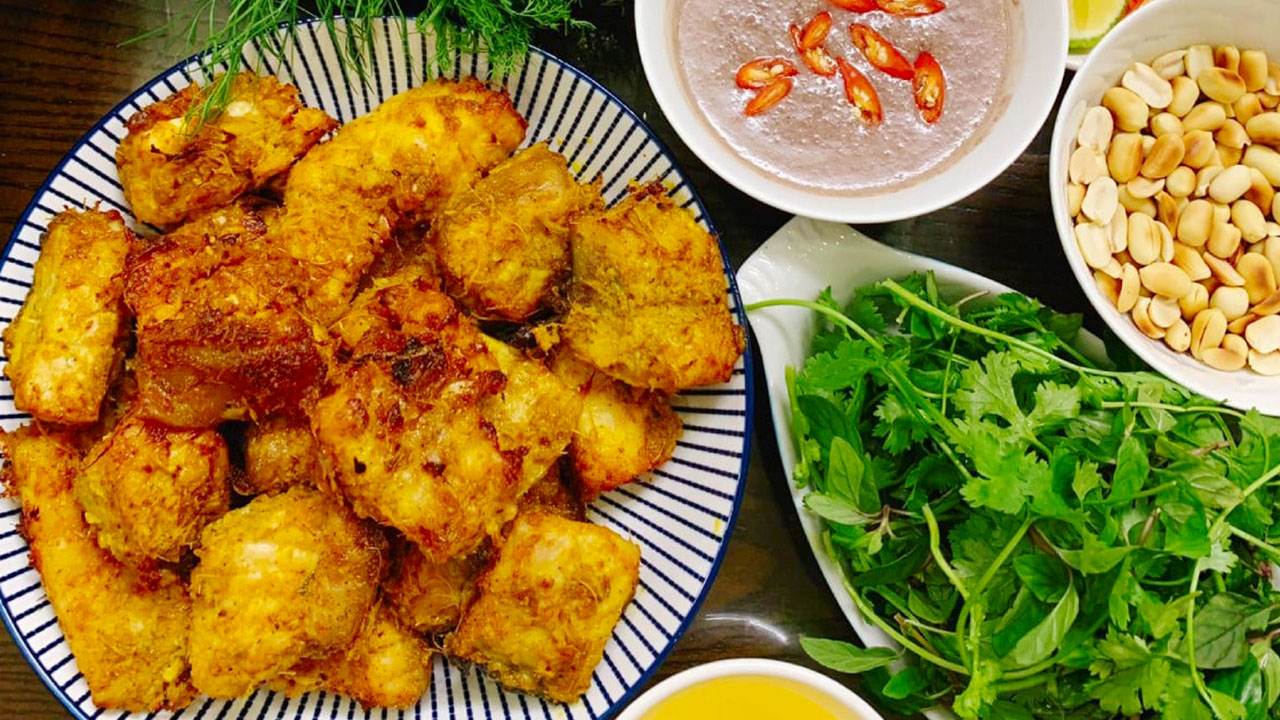
Chả cá, a whole grilled fish embellished with dill and scallions, makes for a lively shared meal. The large catfish is masterfully grilled until flaky on the outside and moist inside. Rice noodles and crunchy greens wrap up this flavorful fish.
Expertly grilling the fish – often a basa or catfish – to golden perfection without drying it out is key. Basting with fish sauce during grilling boosts flavor. Serving the fish alongside the accoutrements allows diners to wrap to their preference.
Lively Spots to Feast Family-Style
Chả cá Lã Vọng, at 14 Cha Ca Street, has been serving this signature Hanoi dish since 1871. Guests grill the fish right at their table. Chả Cá Thăng Long at 19-31 Duong Thanh Street and Chả Cá Hà Nội at 110 Nguyen Trieu Street are also renowned spots to savor this dish.
-
Nem (Spring Rolls)
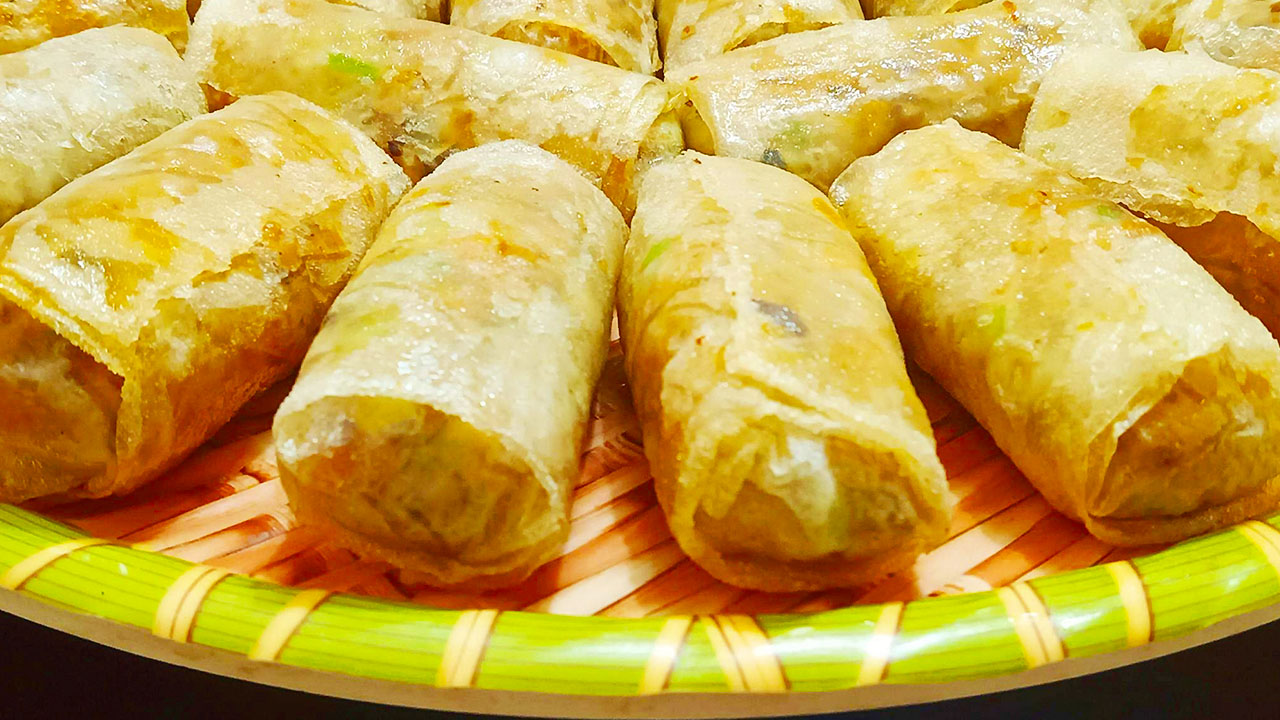
Nem, the quintessential Vietnamese spring rolls, deliver a symphony of flavors bundled in a crispy shell. Thin rice paper wraps up fillings of marinated pork, shrimp, herbs, noodles, and crunchy vegetables. Deep-fried to a shatteringly crisp exterior with a tender filling, these morsels make an addictive snack.
Achieving the desired crispy texture for nem is an art. The rolls must fry at high enough heat to get super crispy without burning. Letting them briefly drain on paper towels post-fry ensures maximum crispness. The accompanying fish sauce dipping sauce lends savory depth.
Where to Sample Street-Style Nem
Check out Nem Cua Be Dac Kim for classic shrimp nem. Bánh Gối Nem Nướng Shiskebab excels at grilled pork nem. Head to Bánh Tráng Nem Thuý for crispy rolls stuffed with pork, herbs and vermicelli. Nem Nắm stands out for its uniquely square-shaped rolls filled with pork and mushrooms.
-
Cốm Hà Nội (Nuggets Hanoi)
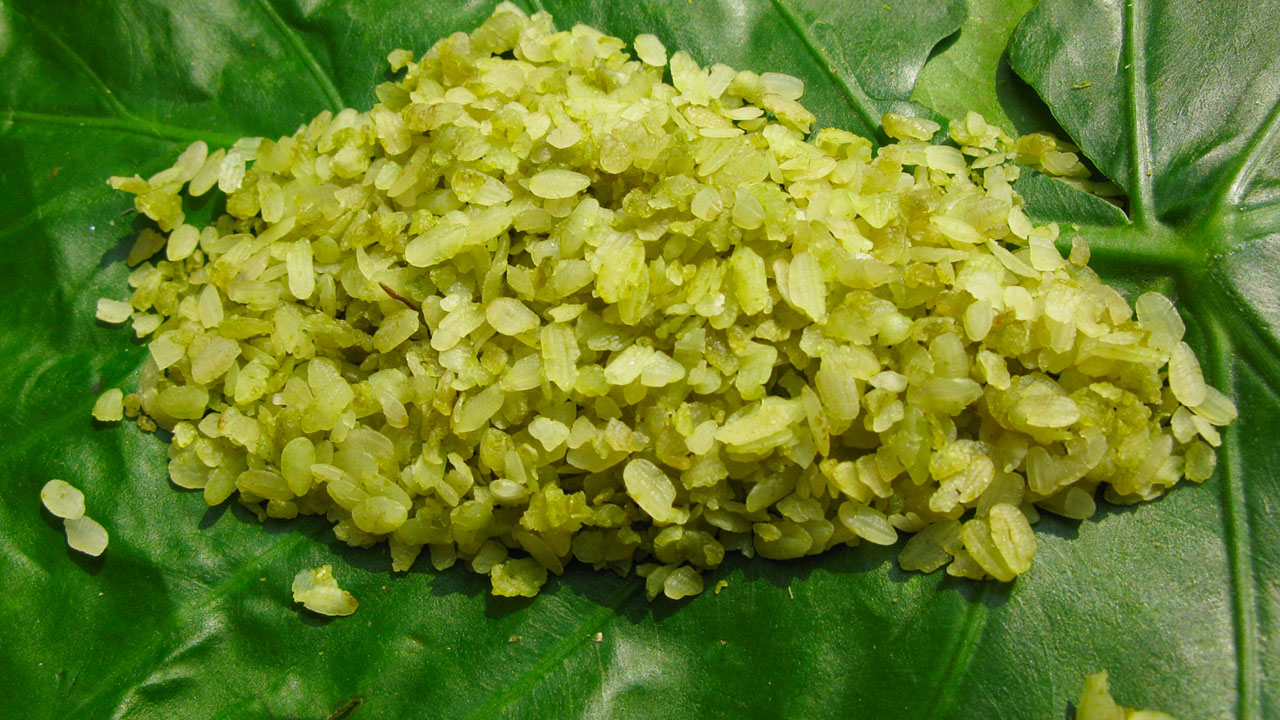
Cốm, roasted green rice flakes, is a cherished specialty of Hanoi dating back centuries. To make cốm, young rice grains are roasted over fire then pounded into tiny flakes. The texture of the flakes contrasts crispy on the outside and soft on the inside. Cốm adorns sweet treats, bringing a delicate crunch.
Autumn’s rice harvest brings the arrival of cốm season in Hanoi, when the flakes are most plentiful. Cốm is highly perishable, retaining optimal freshness for just two days, adding to the delicacy’s mystique. Cốm is often packaged in small sewn bamboo tubes.
Where to Savor the Crunch
Vòng Village just outside Hanoi is renowned for cốm production. You can buy Com Lang Vong on the streets of Hanoi, especially the Cathedral area.
-
Xôi (Sticky Rice)
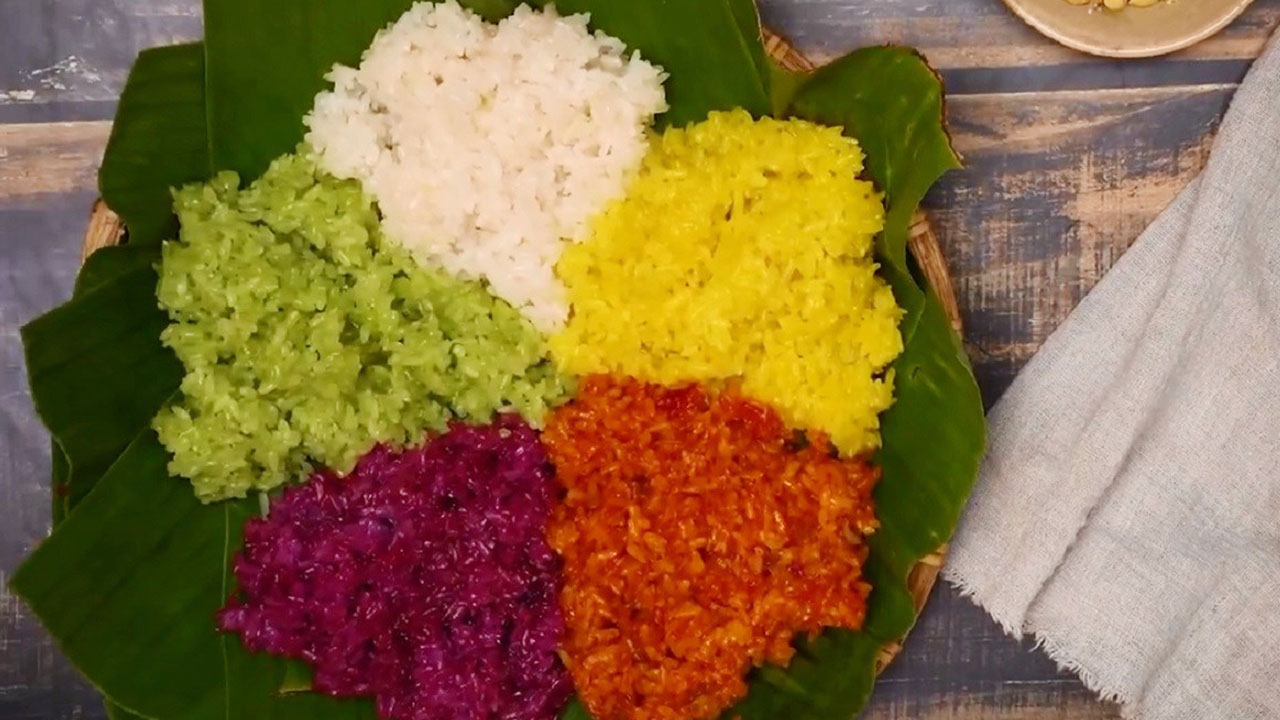
Xôi, sticky rice steamed with various mix-ins, makes for a warm, hearty, and portable meal. Available from street carts across Hanoi, this comforting snack sees the rice cooked until tender and infused with the flavors of the topping. Fillings like mung beans, corn, peanuts, and meat make each version of xôi distinct.
Making xôi involves first perfectly steaming the glutinous rice, resulting in soft, sticky grains. Traditional steaming methods like bamboo baskets over pots lend deep flavor. Toppings are mixed in to preference for customized snacks on the go.
Top Places for Topped Xôi
Xôi Yến, at 35B Nguyễn Hữu Huân Street, draws crowds for xôi topped with meat floss, chili sauce, and quail eggs. Xôi Chè Bà Dậu, on Yen Phu Street, excels at xôi with beans, corn, and peas. Xôi Ngũ Sắc serves vibrantly colorful “five color” xôi topped with sauteed vegetables.
-
Chè (Sweet Soup)
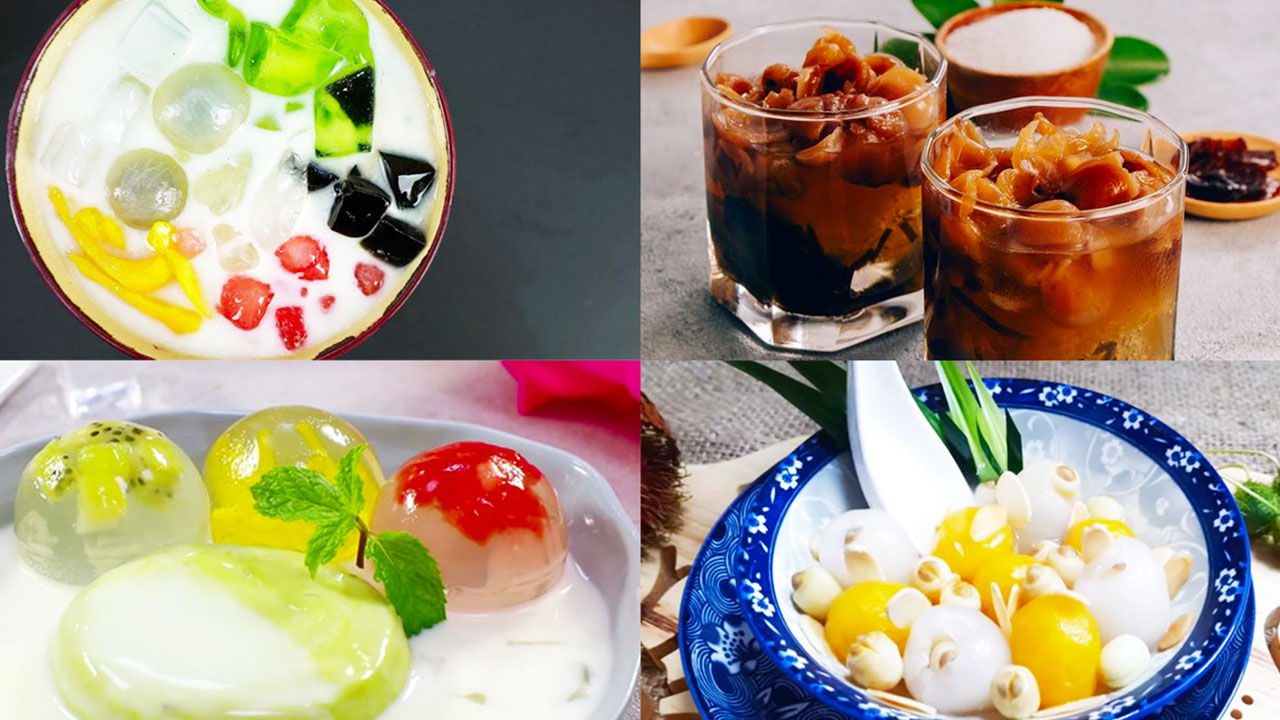
Chè, a comforting Vietnamese sweet soup, makes for an indulgent yet refreshing dessert. Delicately sweet broth provides the base for ingredients like tapioca pearls, mung beans, coconut milk, and fruit. Vibrant green, white, yellow, and pink layers make chè as visually stunning as it is delicious.
Though chè has a sweet foundation, the toppings lend richer flavors. Cooked mung beans offer an earthy depth, while coconut milk contributes creamy richness. Crisp jellies, sticky rice balls, and tropical fruits supply texture and natural sweetness.
Hot Spots for Chè Lovers
Kem Trang Tien, at 35 Trang Tien Street, serves ultra-Instagrammable chè in glasses layered with tapioca pearls, jackfruit, and fluffy milk foam. Chè Mâm, inside the night market at Hang Ma Street, delights with mung bean chè and sheets of crunchy fried dough. Chè Thái, at 52 Dao Duy Tu Street, specializes in Thai-style coconut chè.
-
Kem (Ice Cream)

On sweltering days in Hanoi, kem (ice cream) offers the perfect way to chill out and indulge a sweet craving. Sold from humble street carts, these frozen treats cool you down while serving up flavors from Vietnamese mainstays like coconut and coffee to Western imports like chocolate and strawberry.
Innovative ice cream makers craft an ever-changing array of flavors for kem-seekers. Alongside classic offerings, you can find kem in unique options like durian. Toppings like candied fruits and crunchy nuts add further flair.
Quality Ice Cream Spots
- Kem Tràng Tiền – 35 Trang Tien Street, Hoan Kiem District, Hanoi.
- Kem Fanny French style – 2 Hang Bai Street, Hoan Kiem District, Hanoi.
- Quán kem Thuỷ Tạ – 1 Le Thai To Street, Hoan Kiem District, Hanoi.
-
Trà chanh (Lemon Tea)
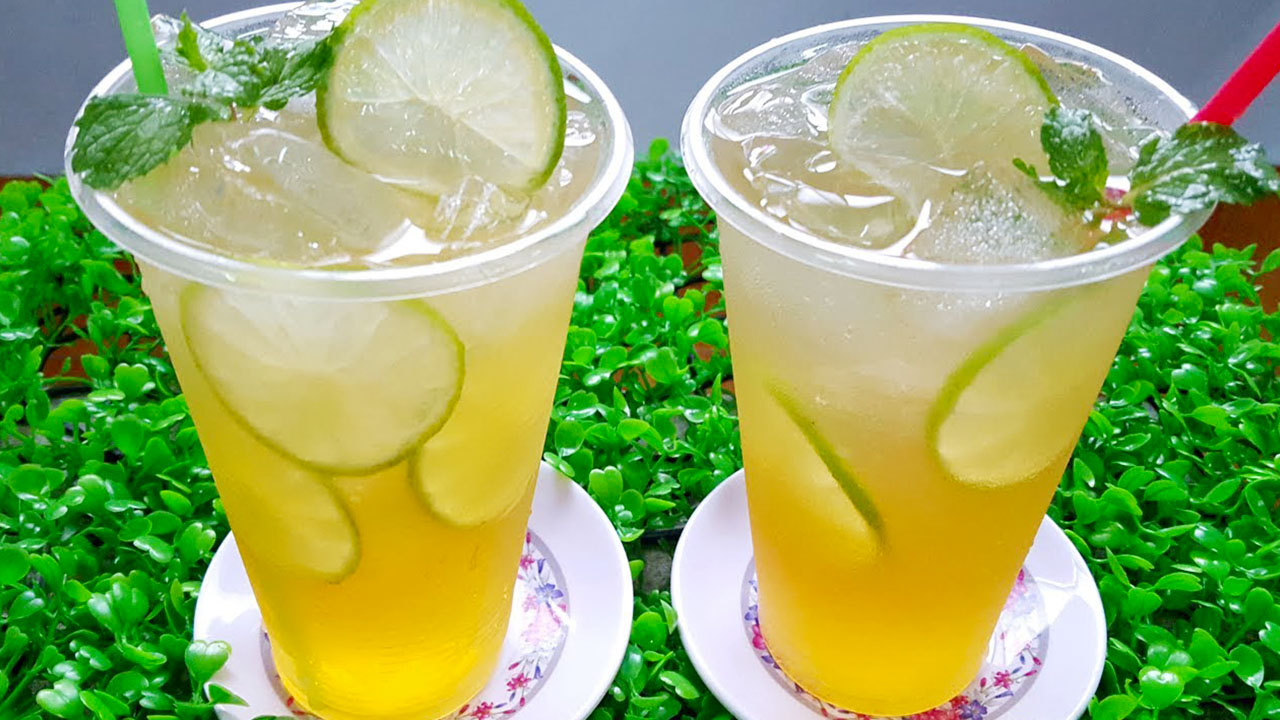
Trà chanh, or lemon iced tea, provides the perfect refreshment for Hanoi’s sweltering summers. Black tea is brewed strong then chilled over ice and spiked with tart and fragrant fresh lemon juice. Simple yet delicious, this punchy iced tea quenches thirst and cools you down. You can enjoy Lemon Tea at the Cathedral area or Ta Hien street.
Conclusion: Street food in Hanoi Old Quarter
From the delicate flavors of bánh cuốn to the smoky aroma of grilled thịt nướng, street food in Hanoi scene truly captivates all the senses. The city’s talented vendors, cooking family recipes handed down through generations, create edible works of art from simple ingredients. Wandering Hanoi’s bustling streets, you’ll find endless inspiration in the tapestry of tastes, colors, and textures that encompass this vibrant culinary culture. Hanoi’s cuisine tells a captivating story – all you need to do is take the first bite.


